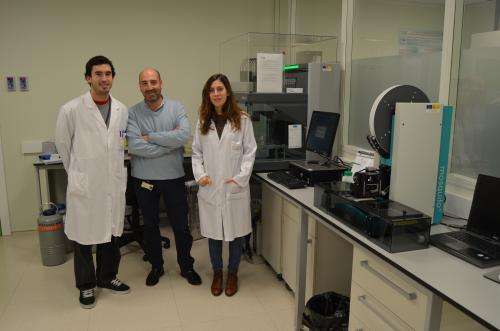3D structure of key protein in fight against Homocystinuria unveiled

Homocystinuria is a disease caused by the deficiency or anomalous function of a protein, with serious consequences such as skeletal deformities, vascular thrombosis and even mental retardation. It is a disease that is classed as "rare" and its incidence varies between 1 in 50,000 and 1 in 200,000 individuals and its mortality rate is 18% by age 30, although some studies reveal higher numbers. The disease is caused by an increased plasma concentration of homocysteine, which is a toxic metabolite.
The key to fight against this disease lies in the CBS protein, which is essential in the regulation of transsulfuration, the process that our body carries out to recycle homocysteine into beneficial amino acids, such as methionine or cysteine.
There has currently been a breakthrough in the fight against homocystinuria thanks to research carried out at CIC bioGUNE, led by Luis-Alfonso Martínez de la Cruz, head of a research team at the X-ray Crystallography Unit. The research has managed to solve the 3D structure of the key enzyme – CBS. The research, in which Martínez Cruz has worked alongside researchers June Ereño and Iker Oyenarte, from CIC bioGUNE, and has collaborated with the University of Colorado, was recently published in the prestigious journal Proceedings of the National Academy of Sciences".
Under normal conditions, homocysteine concentration levels remain within a range finely regulated by the action of several enzymes (proteins that catalyse chemical reactions), which maintain the balance between its production and degradation and prevent it from becoming toxic. The main regulatory enzyme is CBS (cystathionine beta-synthase).
The deficiency in the CBS enzyme's activity is directly connected with mutations in the gene that codes it and an incorrect 3D structure of the protein, causing increased plasma concentration of homocysteine.
This condition is known as hyperhomocysteinaemia or homocystinuria and it is an important risk factor in the development of syndromes causing mental retardation, childhood developmental problems, visual impairment and severe episodes of arterial and venous thrombosis, which cause stroke and heart attacks before 30 years of age.
That is why the research carried out at the laboratory led by Luis-Alfonso Martínez Cruz at CIC bioGUNE is so important, as it provides a breakthrough in the fight against this disease thanks to the discovery of the 3D structure of the CBS protein, an atomic resolution 3D mould, which will help to design drugs that modulate its biological activity. The importance of this protein in the human metabolism makes it an attractive therapeutic target, so it may lead to the future development of drugs that regulate its activity in cases in which its correct function is interrupted by the presence of mutations.
In order to develop these drugs, it is essential to know the 3D structure of this protein, so that the drugs may affect its regulation and way of acting. The fact that this 3D structure has been solved is relevant in two ways: On one hand, it provides a 3D map of the exact location of the mutations described in patients up until now, and this enables the explanation of how these mutations affect the correct function of the enzyme.
On the other hand, it will enable the development of drugs that restore the correct functionality of the enzyme in patients in which it has been rendered useless by a mutation.
The discovery of the 3D structure of the human CBS has been solved using a structural biology technique known as X-ray diffraction crystallography, which involves interpreting the diffraction pattern that is generated when an X-ray beam falls on a protein crystal whose structure is being determined. CIC bioGUNE owns cutting-edge X-ray diffraction facilities.
















